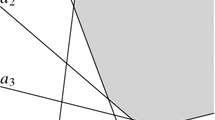Abstract
Kelly’s theorem states that a set of n points affinely spanning \({\mathbb {C}}^3\) must determine at least one ordinary complex line (a line incident to exactly two of the points). Our main theorem shows that such sets determine at least 3n / 2 ordinary lines, unless the configuration has \(n-1\) points in a plane and one point outside the plane (in which case there are at least \(n-1\) ordinary lines). In addition, when at most n / 2 points are contained in any plane, we prove stronger bounds that take advantage of the existence of lines with four or more points (in the spirit of Melchior’s and Hirzebruch’s inequalities). Furthermore, when the points span four or more dimensions, with at most n / 2 points contained in any three-dimensional affine subspace, we show that there must be a quadratic number of ordinary lines.
Similar content being viewed by others
Notes
We note that while the Fermat configuration as stated lives in the projective plane, it can be made affine by any projective transformation that moves a line with no points to the line at infinity.
References
Alon, N.: Perturbed identity matrices have high rank: proof and applications. Combin. Probab. Comput. 18(1–2), 3–15 (2009)
Barak, B., Dvir, Z., Wigderson, A., Yehudayoff, A.: Fractional Sylvester–Gallai theorems. Proc. Natl. Acad. Sci. USA 110(48), 19213–19219 (2013)
Bojanowski, R.: Zastosowania uogólnionej nierówności Bogomolova–Miyaoki–Yau. Master’s thesis, University of Warsaw (2013)
Borwein, P., Moser, W.O.J.: A survey of Sylvester’s problem and its generalizations. Aequationes Math. 40(1), 111–135 (1990)
Brayton, R.K., Coppersmith, D., Hoffman, A.J.: Self-orthogonal latin squares of all orders \(n \ne 2, 3, 6\). Bull. Am. Math. Soc. 80(1), 116–118 (1974)
Csima, J., Sawyer, E.T.: There exist \(6n/13\) ordinary points. Discrete Comput. Geom. 9(2), 187–202 (1993)
de Zeeuw, F.: Ordinary lines in space (2018). arXiv:1803.09524
de Zeeuw, F.: Spanned lines and Langer’s inequality (2018). arXiv:1802.08015
Dvir, Z., Saraf, S., Wigderson, A.: Improved rank bounds for design matrices and a new proof of Kelly’s theorem. Forum Math. Sigma 2, e4 (2014)
Elkies, N., Pretorius, L.M., Swanepoel, K.J.: Sylvester–Gallai theorems for complex numbers and quaternions. Discrete Comput. Geom. 35(3), 361–373 (2006)
Gallai, T.: Solution of problem 4065. Am. Math. Monthly 51, 169–171 (1944)
Green, B., Tao, T.: On sets defining few ordinary lines. Discrete Comput. Geom. 50(2), 409–468 (2013)
Hilton, A.J.W.: On double diagonal and cross latin squares. J. London Math. Soc. 2(4), 679–689 (1973)
Hirzebruch, F.: Arrangements of lines and algebraic surfaces. In: Artin, M., Tate, J. (eds.) Arithmetic and Geometry, Vol. II. Progress in Mathematics, vol. 36, pp. 113–140. Birkhäuser, Boston (1983)
Kelly, L.: A resolution of the Sylvester–Gallai problem of J.-P. Serre. Discrete Comput. Geom. 1(1), 101–104 (1986)
Kelly, L., Moser, W.: On the number of ordinary lines determined by \(n\) points. Canad. J. Math. 10, 210–219 (1958)
Langer, A.: Logarithmic orbifold Euler numbers of surfaces with applications. Proc. London Math. Soc. 86(2), 358–396 (2003)
Melchior, E.: Über vielseite der projektiven ebene. Deutsch. Math. 5, 461–475 (1940)
Motzkin, T.: The lines and planes connecting the points of a finite set. Trans. Am. Math. Soc. 70, 451–464 (1951)
Pokora, P.: The orbifold Langer–Miyaoka–Yau inequality and Hirzebruch-type inequalities (2016). arXiv:1612.05141
Rothblum, U., Schneider, H.: Scalings of matrices which have prespecified row sums and column sums via optimization. Linear Algebra Appl. 114, 737–764 (1989)
Serre, J.-P.: Advanced problem 5359. Am. Math. Monthly 73(1), 89 (1966)
Sylvester, J.J.: Mathematical question 11851. Educ. Times 59(98), 256 (1893)
Acknowledgements
Zeev Dvir: Research was supported by NSF CAREER award DMS-1451191 and NSF Grant CCF-1523816. Shubhangi Saraf: Research was supported in part by NSF Grants CCF-1350572 and CCF-1540634. Charles Wolf: Research was supported in part by NSF Grant CCF-1350572.
Author information
Authors and Affiliations
Corresponding author
Additional information
Editor in Charge: Kenneth Clarkson
Rights and permissions
About this article
Cite this article
Basit, A., Dvir, Z., Saraf, S. et al. On the Number of Ordinary Lines Determined by Sets in Complex Space. Discrete Comput Geom 61, 778–808 (2019). https://doi.org/10.1007/s00454-018-0039-4
Received:
Revised:
Accepted:
Published:
Issue Date:
DOI: https://doi.org/10.1007/s00454-018-0039-4




